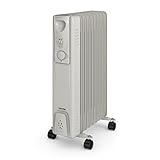List of Top Rated Warm Home 2000w Ceramic Radiator from thousands of customer reviews & feedback.
Updated On Dec 2025
1,332 Reviews Studied
Looking to buy a new Warm Home 2000W Ceramic Radiator? In this buying guide, we will go over everything you need to know before making your purchase. We will discuss the different types of radiators available and the factors you should consider when making your decision. By the end of this buying guide, you will be able to make an informed decision and find the perfect radiator for your sweet home.
A radiator is a heating appliance that transfers heat from one medium to another to warm an area. The heated air then circulates the room, providing warmth and comfort. Radiators can be fueled by gas, oil, or electricity. They come in various shapes and sizes, but all essentially do the same job.
Radiators are an excellent way to heat a room quickly and efficiently. They provide instant heat, which can be very useful on cold winter days. Additionally, radiators distribute heat evenly throughout the room, making it more comfortable to live in. For example, you can choose Wall-Mounted Oil-Filled Radiators for getting heat evenly.
Radiators work by heating up a metal coil. This coil is then placed inside of a tube, which is filled with water. As the radiator heats up, the water inside of the tubes begins to boil. The boiling water creates steam, which rises to the top of the radiator. The steam then escapes out of small vents, warming the air in the room.
Types Of Radiators
The three main types of radiators are column, convector, and radiator. Column radiators have a very slim profile and tend to be more popular in older homes. Convector radiators have fins on the front that help heat up the room faster. They’re often used in new builds and renovations. Radiators are the most common type and can be either panel or cast iron.
Ceramic heaters are a type of radiator that uses convection to move the air around and produce warmth. They’re often used in homes, offices, and other buildings where they can be placed against walls or ceilings without obstructing traffic flow. The ceramic element heats up when electricity passes through it, which creates hot air which rises up through the radiator fins; this then heats other rooms by moving across them before falling back down again as cold air.
The ceramic element is made from a combination of materials, including aluminum oxide and silicon dioxide, which are both heated to high temperatures during manufacturing processes so that they become hard enough not to withstand extreme heat without melting (up to 1400°C).
The heated elements are then placed inside a metal enclosure with fins on top to help dissipate heat into surrounding areas better than just having them exposed alone would do.
This process creates an electric heater that can be used in various ways, including as part of central heating systems, or they may stand alone and provide instant warmth.
Size
Radiators come in various sizes, so it’s important to choose the right one for your home. If you have a small room, you’ll need a small radiator. If you have a large room, you’ll need a large radiator.
Brand
Not all radiators are created equal. Some brands are better than others. Do your research and find a brand that you trust.
Cost
The cheapest option isn’t always the best. You get what you pay for, so if you want a high-quality radiator that will last for decades, you should be prepared to pay more than the average price. Plus, you can purchase accessories like Cheap Radiator Covers Aldi to protect your radiators.
Wattage
The higher the wattage, the more heat your radiator will produce. If you have a large room, you’ll need a high-wattage radiator.
Style
Radiators come in multiple shapes and sizes, so it’s important to choose the right one for your home. If you have the latest model home, you’ll want to purchase a contemporary-style radiator. If you have a bright room; you’ll want to purchase a white or light-colored radiator.
Installation
Some radiators are easier to install than others. If you’re not comfortable installing a radiator yourself, you may want to purchase one that is pre-assembled.
Warranty
A good warranty can be helpful if something goes wrong with your radiator. Choose Plug-In Radiators, which get around a 2-years warranty period. Always read the terms and conditions of the warranty before purchasing a radiator.
Conclusion
In conclusion, when looking to buy a 2000W ceramic radiator, it is important to consider all of the factors mentioned in this informative buying guide. Doing so will help you to find the best radiator for your needs and budget.









